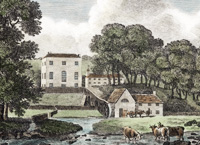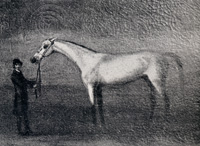 |
|
| Hutton Orientals | |
 Marske Hall  Hutton's Bay Arabian  Moorcock, by Hutton's Blacklegs  Hutton's Grey Barb |
|
| The Hutton family of Marske, in North Yorkshire, had close ties to many of the breeders associated with the early
thoroughbred racehorse, in particular with the Darcy family of Hornby
Castle and Sedbury Park. Matthew Hutton married Barbara Darcy, the sister
of James Darcy the Elder (1617-1673), and their son John Hutton was the
father of John Hutton II (1657-1731). The Huttons owned extensive property
in Yorkshire, including farms, fisheries, orchards and an alum works. The Hutton stud appears to have been established by John Hutton II with the acquisition of Hutton's Royal Colt, "bred by Sir William Ramsden and sold to Mr Hutton in 1700 [GSB 1:382]. Another early acquisition was Hutton's Grey Barb, presented to John Hutton by King William III in 1700 [Pond 1755:203]. From the available records it appears the operation concentrated on offering the services of its stallions in the early years. Hutton's Coneyskins, Hutton's Bay Arabian, Hutton's Bay Barb, Hutton's Bay Turk and Hutton's Surley were others among the roster. Hutton's Bay Arabian and Hutton's Bay Turk were two different horses. Hutton's Bay Barb may have been the same as the Arabian or the Turk. The Hutton stud expanded fairly quickly into one of the most successful breeding operations of the early eighteenth century. John Hutton III (1691-1768), married to Elizabeth Darcy, daughter of James Darcy the Younger (1650-1731), carried on the stud with the bloodstock foundations established by his father. He bred Stripling (ch c 1746 Hutton's Spot) and his sister, who are not further identified, however Sister to Stripling became the taproot mare Family 16 and, although it seems fairly certain she came of earlier Hutton breeding, her background remains a mystery. He also is the breeder of record for Marske (br c 1750 Squirt) whom he traded as a weanling to HRH the Duke of Cumberland in exchange for a chesnut Arabian. Marske went on to become a champion sire and got the legendary Eclipse (ch c 1764). The Hutton stud continued on into the 20th century. Tullynacree (br f 1908 Fowling-Piece), bred by J Hutton, won the Irish Oaks in 1911. |
|
| Hutton's Royal Colt (GB) | |
| c 1685c. "Royal Colt, Mr Hutton's, by the Helmsley Turk - Royal Sedbury Mare, was bred by Sir W Ramsden, and sold to Mr Hutton in 1700" [GSB 1:382]. He is credited with two offspring, the first an unnamed mare, the dam of Surley (gr c 1708 Hutton's Grey Barb) and his sister. The second, the Fen Mare, was the third dam of Black Chance (bl c 1732 Hutton's Arabian), Phantom (gr c 1737 Hobgoblin) and Moorcock (gr c 1740 Hutton's Blacklegs). For more information see Hutton's Royal Colt. | |
| Hutton's Bay Arabian | |
| b c 1720c. Hutton's Arabian got three offspring: one unnamed
filly and two colts. (1) The filly was the dam of Mr
Hutton's Merryman (gr c 1742 Spot)
who won at Hambleton, York and Bishop-Auckland. She also produced Shock*
(b c 1750 Shock),
who was sent to Virginia in 1756 and there joined the stud of Colonel John
Baylor in Caroline County. He appears in several old Virginia pedigrees.
(2) Smart (b c 1732) finished second for 30gs at Durham in 1736. (3) Black Chance - see below. |
|
| Black Chance (GB) | |
| bl c 1732 (Hutton's Arabian - Mare, by Hutton's Surley - Mare, by Hutton's Coneyskins - Fen Mare, by Hutton's Royal Colt - Mare, by Blunderbuss - Old Thornton Mare, by Place's White Turk - Barb Mare). Black Chance was a good runner and a moderate stallion, winning King's Plates at Guildford, Salisbury, Winchester, Lewes and Lincoln, as well as many other prizes, defeating such good horses as Beaver's Driver (ch c 1732 Snake), and Sir Michael Newton's Elephant (gr c 1734 Bloody Buttocks). In the stud Black Chance got over a dozen known offspring including Richard Williams's good winner Cricket (b c 1747) and Sir Peter Leicester's Bonny Lass* (b f 1751). Bonny Lass was advanced by Fairfax Harrison as the mare imported to America and there ancestress of a branch that includes such descendants as Old Tristram Shandy (ch c 1762c Morton's Traveller*), Blick's Pegasus (b c 1783 Symme's Wildair) and Grave and Gay (b f 1899 Henry of Navarre). Sent to Germany the latter founded a large family of good winners such as Graf Ferry (b c 1918), Grosser Preis von Baden winner Gradivo (b c 1939 Ladro) and the Irish St Leger winner Authaal (b c 1893). | |
| Hutton's Bay Barb | |
| b c 1710c. Hutton's Bay Barb sired one offspring: an unnamed filly, who was the ancestress of Lord Clermont's Amethyst (b c 1772 Chrysolite), a moderate runner who won two 100gs matches at Newmarket. | |
| Hutton's Bay Turk | |
| [Mulso Turk] b c 1710c. The General Stud Book itself notes that Hutton's Bay Turk and the Mulso Turk were identical [GSB 1:391]. Hutton's Bay Turk got Hutton's Blacklegs (c 1725) and four unnamed fillies, one of them Sister to Blacklegs. (1) Blacklegs is probably best known as the sire of the Ruby Mare who foaled the Champion Sire Marske (br c 1750 Squirt) who in turn got the legendary Eclipse (ch c 1764). He also got Lord Portmore's Moorcock (gr c 1740) who won fifties at York, Nottingham, Huntingdon and Windsor as well the Ladies Purse at Oxford and Lincoln. (2) The first filly was the ancestress of Christopher Blake's Giboutski (b c 1767 Gibson's Arabian) who won a 200gs match at Newmarket, as a two year old, from the distinguished six year old mare Stilts (b f 1763 Genius). (2) The second filly was ancestress to Mr Wentworth's Valentine (b c 1765 Young Cade) who won a number of matches at Newmarket. (3) The third filly was the ancestress of much of Family 8 as well as the grandam of the winners Mixbury (ch c 1743 Hutton's Spot), Anthony (gr c Hutton's Spot) and Bay Ranger (b c 1749 Hutton's Spot). She was also the third dam of Chesnut Ranger (ch c 1759 Regulus). Mixbury won several fifties; Anthony won a fifty at Grantham for his owner Lord Ferrers. Bay Ranger enjoyed somewhat more success, winning fifties at Bishop-Auckland, Stockton and Carlisle, and getting Mr Hutton's stallion Arbitrator (b c 1766). Chesnut Ranger won the King's Plate Carlisle in 1764. (4) The fourth filly, a sister to Blacklegs, left no offspring. | |
| Hutton's Grey Barb | |
| [Hutton's
White Barb] gr c 1695c. Sire Line Hutton's
Grey Barb.
Surley
(GB) Surley (GB) [Routh's] gr c 1720, (Hutton's Surley - Mare, by Coneyskins). Sire Line Hutton's Grey Barb. Family 34. He was purchased by Cuthbert Routh, of Snape Hall, Bedale, Yorkshire, from John Hutton in April of 1725 for 100 guineas. After winning two races he was sold to Mr Herbert for 250 guineas, plus another 50 guineas after Surley had won £100 for his new owner. Surley is said to have won a stakes at Richmond and later he won the £60 Ladies' Gold Cup at York, in August of 1725, beating Stephen Jefferson's Quintin (ch c 1720 Skipjack). The great racemare Ladylegs, later called Bald Charlotte (ch f 1721 Old Royal), who was only four, placed eighth in this race. Surley was described as a horse "much superior in strength to Quintin" which allowed him to win the race "with much difficulty" as the end of the course was very heavy due to overmuch rain and Quintin's jockey took him wide around the wet [Orton:19]. Surley left no stock that bred on. Whitefoot (GB) ch c 1709 (Hutton's Grey Barb - mare, by Byerley Turk). Sire Line Hutton's Grey Barb. Family 2. Bred by John Hutton he was later sold to the Duke of Rutland. He won the £60 Gold Cup at York in 1715 beating Mr Metcalfe's Bulle Rock (b c 1709 Darley Arabian), the first "bred" horse sent to America and three others. Whitefoot doesn't appear to have left any offspring. |
|
| Hutton's Grey Barb | |
| gr c 1755c. This horse has one offspring in the General Stud Book, the Duke of Bolton's colt (b c 1761) from a Blaze Mare that Mr Pratt purchased at the Duke of Bolton's sale at Richmond in 1765. Another offspring, not in GSB, was Henry Fletcher's filly (1761) that was advertised for sale with her dam Sprightly (ch f 1743 Fletcher's Arabian) in 1761. Neither colt nor filly is further recorded. | |
| Hutton's Arabian | |
| ch c 1745c. According the Hutton stud book, HRH the Duke of Cumberland traded a Chesnut Arabian with John Hutton in exchange for the weanling later called Marske (b c 1750 Squirt). The Arabian is credited with two offspring in the General Stud Book, Mr Hammond's unnamed filly (b f 1758) and the Duke of Bolton's unnamed colt (b c 1760), both from a Blaze Mare that Mr Pratt purchased at the Duke of Bolton's sale at Richmond in 1765. Neither offspring is further mentioned in the calendars or stud books. | |